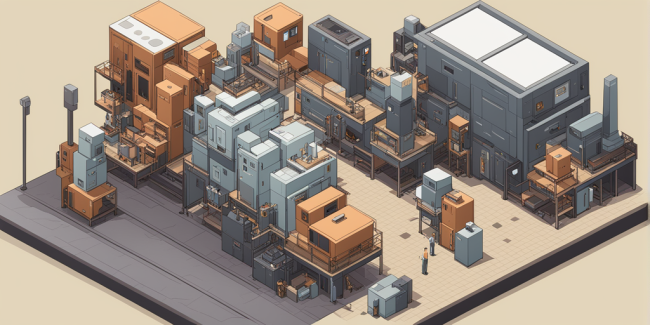Ready to explore equipment management? Let's break down the concept and understand the significance of comprehensive lifecycle assessment. By the end of this journey, you'll navigate the terrain of equipment management without a stumble. So sit tight and let's unravel the mysteries together.
The Importance of Equipment Management
Enhancing Efficiency and Productivity
Streamlining processes in equipment management can elevate productivity and efficiency. Technologies like asset tracking software, for example, simplify monitoring and administration, curtail downtime, and increase output. Implementing maintenance schedules and routine checks can prevent unforeseen malfunctions ensuring a smooth workflow. The result is more productive operations, reduced expenses, and customer satisfaction.
Reducing Downtime and Repair Costs
The goal of effective equipment management is to reduce downtime and maintenance charges. Regular preventive maintenance, like routine servicing and inspections, can vastly lengthen the life of your machinery, and forestall unexpected malfunctions. For instance, swapping worn parts and filters on schedule can thwart costlier future fixes. Further, comprehensive training for operators reduces errors, thereby lessening damage or misuse.
Prioritizing such preventive measures reduces downtime and repair costs.
Minimizing Environmental Impact
Equipment management also factors in environmental consciousness. Employing energy-efficient machinery lowers energy consumption and greenhouse gas emissions. For instance, LED lights compared to incandescent bulbs, consume less power and last longer. Proper waste management, like recycling, also plays a crucial role. Such initiatives significantly help in lowering our carbon footprint.
Understanding Equipment Lifecycle Assessment
Defining Equipment Lifecycle Assessment
Equipment Lifecycle Assessment (ELA) evaluates the entire lifespan of equipment, from acquisition to disposal. Consideration factors include maintenance costs, energy efficiency, and durability. For instance, the Total Cost of Ownership (TCO) accounts for a vehicle's initial price, fuel, and maintenance expenditure. Similarly, when assessing electronic devices, aspects like battery life and software updates are evaluated.
A complete understanding of the equipment's lifecycle aids in informed decision-making and optimal resource allocation. Learn more about facility maintenance software.
Key Components of Equipment Lifecycle Assessment
ELA involves evaluating different stages of an equipment's lifespan. Such an assessment aids in understanding overall performance, cost-effectiveness, and environmental impact. For instance, during acquisition, scrutinizing historical data on maintenance needs can foretell long-term reliability. During operation, regular monitoring and data analysis can something unexpected and optimize outputs.
Finally, during disposal, respectful recycling and waste management practices can reduce environmental damage.
Benefits of Equipment Lifecycle Assessment
Conducting an ELA provides various benefits:
Increased efficiency: ELA helps identify and rectify process glitches, leading to long-term cost savings.
Enhanced equipment function: Regular assessment enables the identification of underperforming or risky equipment, preventing costly downtime.
Monetary savings: Lifecycle assessment allows for strategic management of repairs, replacements, and upgrades thereby minimizing wasteful expenditure.
Environmental sustainability: ELA provides insights into the environmental implications, suggesting areas for more eco-friendly practices.
Implementing Effective Equipment Management Strategies
Tracking Equipment Performance and Usage
Observing equipment utilization is paramount to proficient equipment management. Metrics like equipment downtime and repairs can indicate potential issues, allowing for early prevention and minimizing downtime.
Implementing Preventive Maintenance Programs
Preventive maintenance programs are essential for efficient equipment management. Scheduled maintenance like regular oil changes, filter replacements, and routine inspections help maintain optimal performance. Proactive measures like these reduce repair costs and enhance productivity.
Utilizing Technology for Equipment Management
Digital advancements have revolutionized equipment management. IoT sensors offer real-time performance data, enabling predictive maintenance and reducing downtime. Cloud-based software simplifies coordination and tracking across multiple locations. Leveraging technology in equipment management leads to streamlined processes, improved productivity, and cost reductions.
Equipment Management in the Construction Industry
Effective management of machinery in construction influences productivity and operational flow. Regular maintenance aids in preventing breakdowns and extending the life of machinery. Efficient scheduling and tracking can optimize the allocation of resources and reduce idle time. Effective equipment management facilitates efficiency, cost-effectiveness, and punctuality in project delivery.
Equipment Management in the Healthcare Sector
Equipment management is pivotal in healthcare, allowing for efficient operations and optimal patient care. Regular maintenance schedules for medical devices prevent unexpected malfunctions, ensuring uninterrupted service. An organized inventory system tracks equipment usage and minimizes the risk of misplacement or loss. Staying current with equipment management practices is a prime necessity for healthcare facilities.
Conclusion
Navigating equipment management becomes simpler with comprehensive lifecycle assessments. These provide a holistic perspective of the equipment, considering factors like energy efficiency, total cost of ownership, and environmental impact. Such practices ensure maximum efficiency and sustainability throughout an equipment's lifecycle, including keeping up with equipment maintenance.
